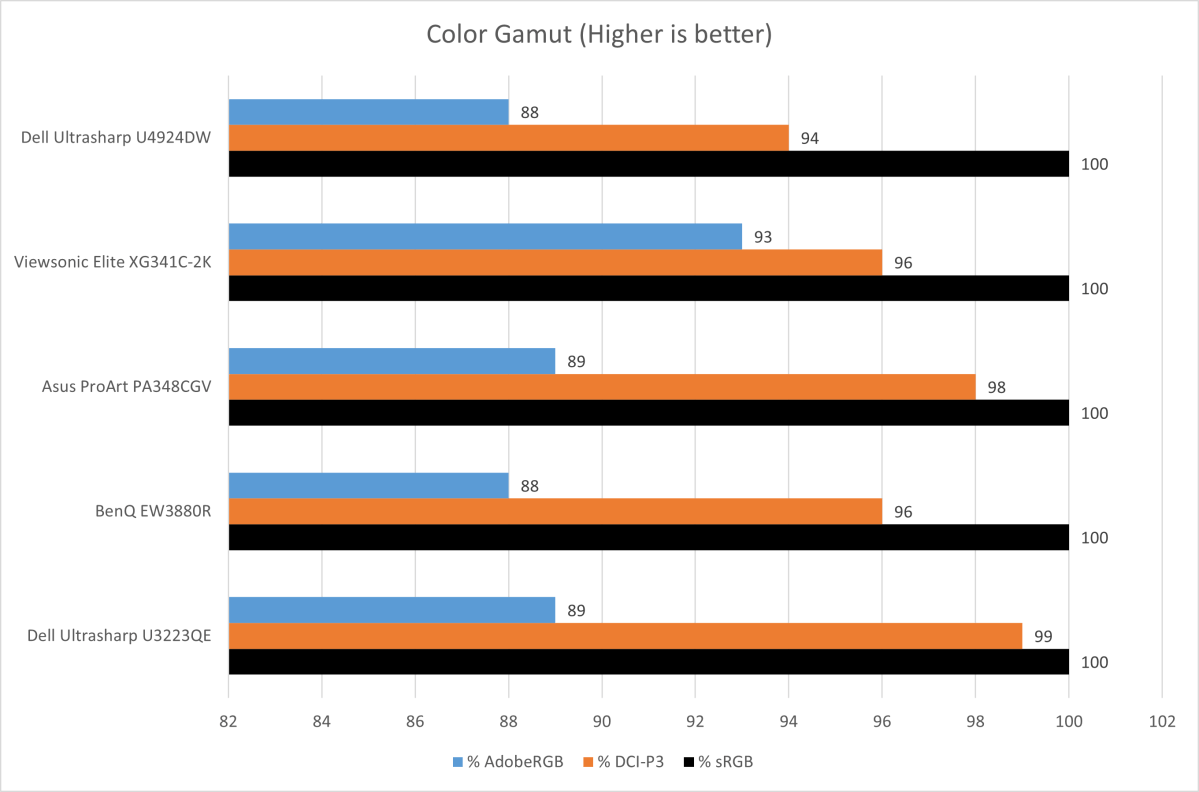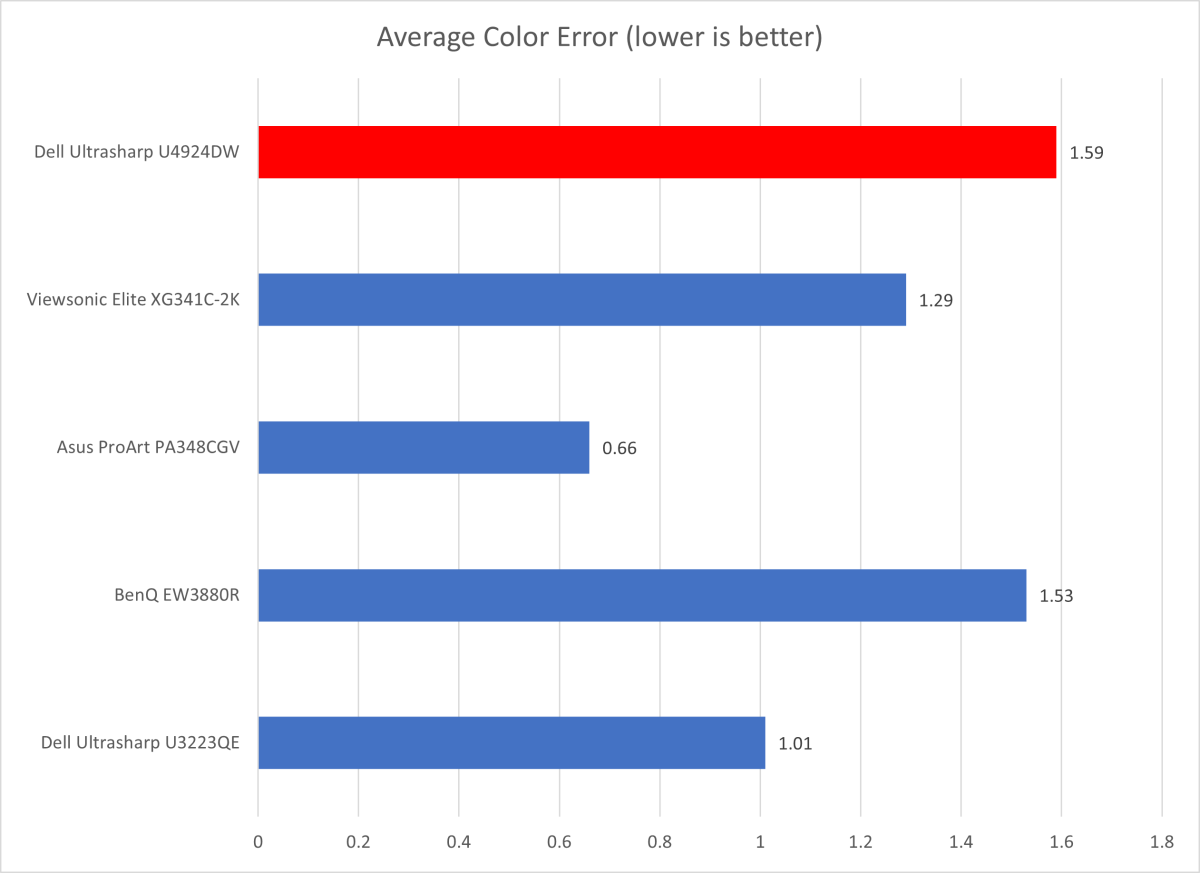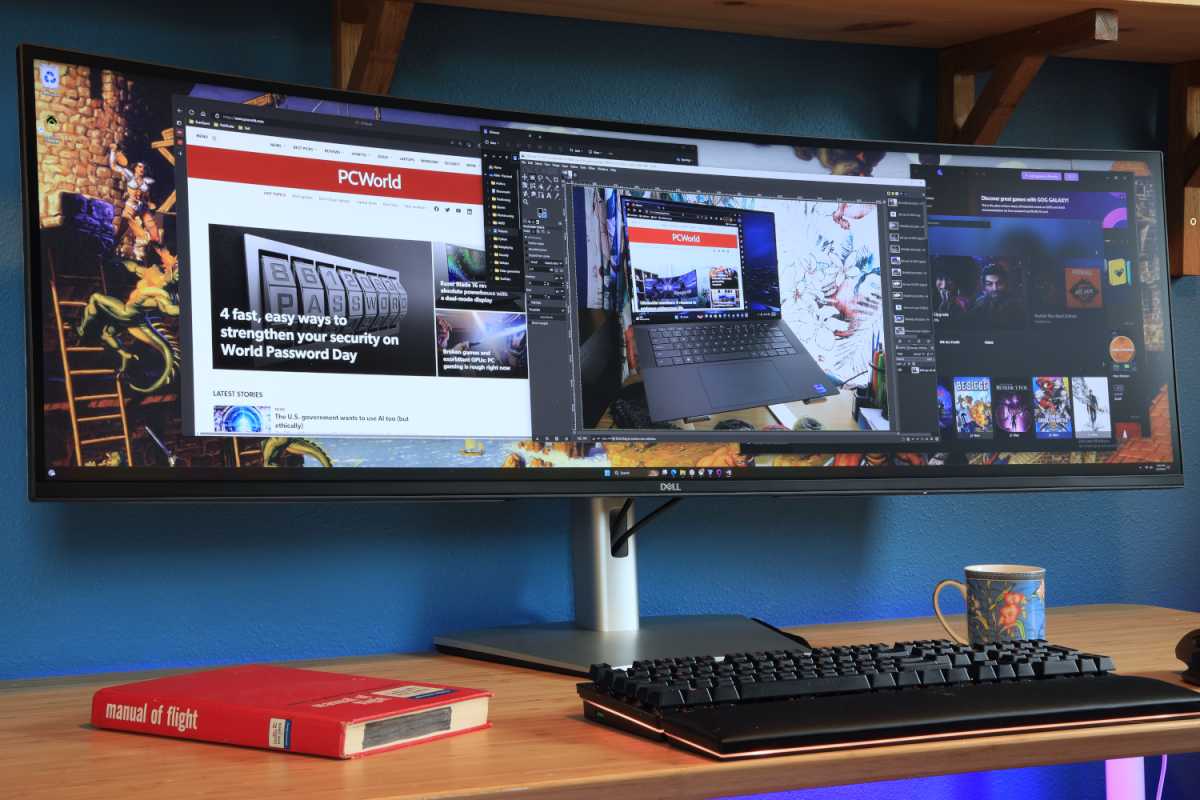
 Image: Matt Smith/Foundry
Image: Matt Smith/Foundry
At a glance
Expert’s Rating
Pros
Excellent build quality and standLots of connectivity including USB-CEasy-to-use menu with numerous optionsIPS Black improves contrast ratio
Cons
Image quality is mediocre overallNo HDR or Adaptive SyncExpensive for its feature set
Our Verdict
Dell’s super-ultrawide Ultrasharp U4924DW goes all-in on productivity, and it shows.
Best Prices Today: Dell Ultrasharp U4924DW
RetailerPrice $1239View Deal
$1239View Deal

Most super-ultrawide monitors have an extreme curve for maximum immersion, but that curve can be a distraction when it’s time to clock in. The Dell Ultrasharp U4924DW is a practical alternative with a less aggressive curve, more restrained image quality, and tons of connectivity. It’s a solid pick if you need a super-ultrawide for work.
Further reading: See our roundup of the best ultrawide monitors to learn about competing products.
Dell Ultrasharp U4924DW specs and features
The U4924DW’s display specifications are typical of a 49-inch super-ultrawide monitor, with one exception: It has an IPS Black panel. This relatively new panel, produced by LG, promises better contrast and improved dark scene performance.
Display size: 49-inch 32:9 super-ultrawideNative resolution: 5120×1440Panel type: IPS Black LCDRefresh rate: 60HzAdaptive-Sync: NoneHDR: NonePorts: 1x USB-C with DisplayPort Alternate Mode and 90 watts Power Delivery, 4x USB-A, 2x USB-C, USB-B, 2x HDMI, DisplayPort, audio line-out, EthernetStand adjustment: Height, tiltVESA mount: Yes, 100x100mmSpeakers: Yes, 2x none-wattPrice: $1599.99
But it’s arguably the monitor’s connectivity that deserves center stage. The monitor acts as a USB-C hub that provides a total of six downstream USB ports (four USB-A, two USB-C) plus Ethernet and audio-out.
Dell Ultrasharp U4924DW design
The Dell Ultrasharp U4924DW’s design is unusual for a simple reason: It’s curved, but only just. It’s a stark contrast against popular super-ultrawide gaming monitors like the Samsung Odyssey Neo G9, which seem to wrap around the user’s field of view, and more similar to the LG 49WL95C-WE, a competitive super-ultrawide productivity monitor.
Toning down the curve has perks. An extremely aggressive curve can seem more immersive in games but also distorts the image. Lines that appear straight may instead seem curved, which isn’t ideal when image accuracy and consistency matters. Aggressive curves also amplify glare, especially from light sources directly behind the user. The Dell U4924DW will still show some glare, but the less aggressive curve and anti-glare finish are an effective combination.

Matt Smith/Foundry
Matt Smith/Foundry
Matt Smith/Foundry
Curve aside, the U4924DW adopts the usual Dell Ultrasharp design language. That means thin black bezels and silver faux-metallic plastics across most of the rear display panel and stand, although the stand base seems to be real metal. The monitor is noticeably more robust than competitive super-ultrawides from LG and Samsung which, in my experience, tend to creak and groan when handled.
The practical stand is hefty and keeps the monitor planted yet doesn’t take up excess space on a desk. This, too, is an advantage over Samsung and LG alternatives which use wide, beefy stands that leave large portions of your desk unusable. The U4924DW supports both 100x100mm and 200x100mm VESA mount patterns, providing a wide range of options for third-party monitor stands and arms. The monitor’s panel is heavy at 27 pounds, however, so you’ll need a top-tier monitor arm to support it.
Dell Ultrasharp U4924DW features and menus
Dell’s Ultrasharp U4924DW boasts an impressive array of connectivity surpassing other super-ultrawide monitors currently available.
The highlight is the USB-C port with DisplayPort Alternate Mode and an impressive 90 watts Power Delivery, which lets owners connect and charge a laptop or tablet simultaneously. The USB-C port also acts as a hub for access to four USB-A, two USB-C ports, and an ethernet port. The monitor can completely replace most USB-C hubs and midrange USB-C docks.
Those who don’t want to connect to the monitor over USB-C can instead use a USB-A to USB-B cable to access the monitor’s connectivity.
Additional video connectivity comes from two HDMI inputs and a single DisplayPort input, bringing the total number of video inputs to a healthy four. The monitor is missing a second DisplayPort-out port for connecting a second monitor directly to the U4924DW, which I find odd: Less expensive monitors in this model line, like the Dell U3223QE, have that feature. I can’t be too harsh about its exclusion, though, as I can’t think of a competing super-ultrawide that offers it.
Dell’s menu system is controlled by a joystick on the monitor’s right lower flank. It’s logically arranged and easy to navigate thanks to responsive controls, relatively large font sizes, and clear menu labels. Image-quality options include color temperature presets that target specific color temperature values, color hue, gain, offset, and saturation adjustment, and several modes that target a specific color gamut, such as sRGB and DCI-P3. There’s no gamma adjustment, however.
Like most super-ultrawides, the U4924DW presents a buffet of picture-in-picture and picture-by-picture modes. Users can split the screen in half or divvy or access a variety of picture-in-picture modes that place the PIP image in different locations on the display.
The U4924DW includes two 9-watt speakers that deliver acceptable volume. The lack of low-end oomph and sometimes harsh quality of highs makes them a poor choice for music, but they’re great for podcasts, video calls, and most YouTube content. Most super-ultrawides don’t have speakers or, if they do, use weak speakers that can be difficult to hear even at maximum volume.
The monitor can completely replace most USB-C hubs and midrange USB-C docks.
Dell Ultrasharp U4924DW image quality
The Dell Ultrasharp U4924DW is not an inexpensive monitor, so it’s reasonable to expect top-tier image quality. It delivers, though perhaps not in the ways display enthusiasts would expect. It’s an unapologetic productivity monitor.

Matt Smith/Foundry
Matt Smith/Foundry
Matt Smith/Foundry
Brightness comes in at a maximum of 333 nits. As the graph shows, there’s an extremely wide range of brightness among today’s high-end ultrawide and super-ultrawide monitors, and the Dell U4924DW lands smack in the middle. It’s bright enough for use in nearly all situations, though it might seem a bit dim in a room lit by floor-to-ceiling windows on a sunny day.

Matt Smith/Foundry
Matt Smith/Foundry
Matt Smith/Foundry
The U4924DW has a new type of IPS panel called “IPS Black” which promises an improved contrast ratio thanks to lower luminance in dark areas of the image. It delivers a contrast ratio of 1,510:1, much higher than conventional panels, which range between 800:1 and 1200:1, depending on the display. The monitor’s lower minimum luminance helps to rein in the dreaded “IPS glow,” or hazy gray sheen present in dark scenes on most IPS displays.
With that said, the U4924DW’s contrast is behind alternatives with a Mini-LED backlight, such as the Viewsonic Elite XG341C-2K or Samsung Odyssey Neo G9. They serve up a superior sense of depth in games and movies.

Matt Smith/Foundry
Matt Smith/Foundry
Matt Smith/Foundry
Color gamut performance is a tad underwhelming, spanning 94 percent of DCI-P3 and 88 percent of AdobeRGB. That’s good enough for most users and also above average for a monitor, but it’s the worst performance in this competitive set.
Interestingly, the U4923DW ships with a default color gamut setting that spanned only 89 percent of DCI-P3 and 88 percent of AdobeRGB. This appears to be an sRGB mode that aims to provide a more accurate look in everyday use and avoid oversaturated colors. It’s successful and makes sense given the monitor’s focus on office productivity, but would-be owners should make note of this quirk. The monitor should be manually set to DCI-P3 or Custom Color mode to achieve the widest possible color gamut.

Matt Smith/Foundry
Matt Smith/Foundry
Matt Smith/Foundry
Color accuracy is better than it appears in the graph. The monitor’s color error is the highest of this bunch, but all of these monitors perform well and are unlikely to present any problem in real-world use. The image appears realistic, pleasant, and lifelike. Also, as mentioned, the monitor has extensive color calibration options that help users change any aspect of color presentation they dislike.
The monitor’s default color temperature came in at 6900K, a tad cooler than the target of 6500K, and the gamma curve came in at 2.1, which indicates content may appear a bit brighter than it should. Neither variance is drastic though, at this price, I did expect to see a spot-on color temperature reading of 6500K.
Sharpness is excellent. The monitor’s 5120×1440 resolution is equivalent to a 27-inch 1440p monitor and packs roughly 109 pixels into each inch. A 27-inch 4K monitor is much sharper at 163 pixels per inch, but this comparison is a bit academic, as no super-ultrawide sold today beats a vertical resolution of 1440p. This is as sharp as it gets at this size and aspect ratio.
The U4924DW’s image quality is mediocre overall but well suited to its intended task. It’s bright enough for use in most offices and offers a sharp, accurate image with good contrast. The monitor lacks the hyper-realistic, oversaturated look common to high-end monitors, and that will disappoint those looking to play games or watch movies.
Dell Ultrasharp U4924DW HDR image quality
The Dell Ultrasharp U4924DW does not support HDR, which may come as a surprise given its price. However, the monitor’s focus on productivity makes the absence of HDR understandable. Office tasks and Windows desktop applications rarely benefit from the enhanced color range and contrast provided by HDR. Choosing to omit HDR presents shoppers with an easy choice: If you want HDR, don’t buy the U4924DW.
Dell Ultrasharp U4924DW motion performance
The motion clarity of the Dell Ultrasharp U4924DW is satisfactory for its 60Hz refresh rate, but not better than competitors. Fast-moving objects are noticeably lacking in detail and scrolling across an image or webpage will make most content illegible.
The absence of Adaptive Sync makes it less than ideal for gaming, as screen tearing or micro-stutters may appear when a game’s framerate deviates from 60fps. Gamers will want to use a V-sync option in games which provide it.
Games can be enjoyed despite these flaws, but competitors like the Samsung Odyssey Neo G9, which has a 240Hz refresh rate and supports both AMD FreeSync and Nvidia G-Sync, are superior in games.

Matt Smith/Foundry
Matt Smith/Foundry
Matt Smith/Foundry
Is the Ultrasharp U4924DW worth it?
Dell’s Ultrasharp U4924DW is a super-ultrawide built for a specific demographic. It drops features that target games and entertainment like an aggressive curve, enhanced refresh rate, and HDR, in favor of a simple, functional display that’s comfortable and attractive when using basic productivity applications.
The monitor also delivers outstanding USB connectivity that can replace a standalone USB-C hub or dock. The U4924DW pairs well with a USB-C laptop, as it can charge the laptop while improving its connectivity.
Pricing is an obstacle, as Dell charges a stiff MSRP of $1,599. That’s equivalent to alternative monitors with better image quality like the Samsung Odyssey Neo G9 and Corsair Xeneon Flex. Still, the U4924DW is a good choice if you plan to spend more time in Microsoft Excel than League of Legends.
Best Prices Today: Dell Ultrasharp U4924DW
RetailerPrice $1239View Deal
$1239View Deal

Author: Matthew S. Smith
Matthew S. Smith is a freelance technology journalist with 15 years of experience reviewing consumer electronics. In addition to PCWorld, his work can be found on Wired, Ars Technica, Digital Trends, Reviewed, IGN, and Lifewire. Matthew also covers AI and the metaverse for IEEE Spectrum and runs Computer Gaming Yesterday, a YouTube channel devoted to PC gaming history.
Recent stories by Matthew S. Smith:
Pixio PX248 Wave review: A monitor for fashion, flair, and clarity on a budgetBest portable monitors 2024: Displays that go with youBest ultrawide monitors 2024: Let’s get large



